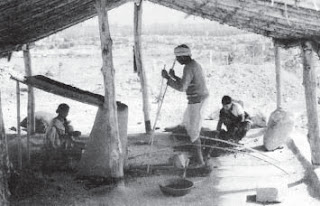In the Yantra Sarvasva,
sage Maharshi Bhardwaj
describes vimana, or
aerial aircrafts, as being
of three classes:
1. Those that travel
from place to
place;
2. Those that travel
from one country
to another;
3. Those that travel
between planets.
Of special concern
among these were the
military planes whose
functions were delineated
in some very
considerable detail and
which read today like something clean out of science fiction. For instance,
they had to be: Impregnable, unbreakable, non-combustible and
indestructible capable of coming to a dead stop in the twinkling of an eye;
invisible to enemies; capable of listening to the conversations and sounds in
hostile planes; technically proficient to see and record things, persons,
incidents and situations going on inside enemy planes; know at every stage
the direction of the movement of other aircraft in the vicinity; capable of
rendering the enemy crew into a state of suspended animation, intellectual
torpor or complete loss of consciousness; capable of destruction; manned by
pilots and co-travelers who could adapt in accordance with the climate in
which they moved; temperature regulated inside; constructed of very light
and heat absorbing metals; provided with mechanisms that could enlarge or
reduce images and enhance or diminish sounds.
The "Rama Empire" of
Northern India and Pakistan
developed at least fifteen
thousand years ago on the
Indian subcontinent was a
nation of many large,
sophisticated cities, many of
which are still to be found in the
deserts of Pakistan, northern, and western India. Rama existed parallel to the Atlantean civilization and was
ruled by "enlightened Priest-Kings" who governed the cities. The seven
greatest capital cities of Rama were known in classical Hindu texts as the
Seven Rishi Cities and the people had flying machines called "Vimanas." The
ancient Indian epic describes a Vimana as a double deck, circular aircraft
with portholes and a dome, much as we would imagine a flying saucer. It
flew with the "speed of the wind" and gave forth a "melodious sound." There
were at least four different types of Vimanas; some saucer shaped and
others like long cylinders (cigar shaped airships). The ancient Indian texts on
Vimanas are so numerous that it would take volumes to relate what they had
to say. The ancient Indians, who manufactured these ships themselves,
wrote entire flight manuals on the control of the various types of Vimanas,
many of which are still in existence and some have even been translated into
English.
According to Rahasyagnyodhikaaree - Sutra 2, "The pilot is one who knows
the secrets" There were 32 secrets the pilot needed to learn from competent
preceptors and only such a person was fit to be entrusted with an aeroplane,
and no others:
There are 32 secrets of the working of the Vimaana. He must know the
structure of the aeroplane, know the means of its take off and ascent to the
sky, know how to drive it and how to halt it when necessary, how to
maneuver it and make it perform spectacular feats in the sky without
crashing. Those secrets are given in "Rahashya Lahari" and other works by
Lalla and other masters and are described as thus:
"The pilot should have had training in maantrica and taantrica, kritaka and
antaraalaka, goodha or hidden, drishya and adrishya or seen and unseen,
paroksha and aparoksha, contraction and expansion, changing shape, look
frightening, look pleasing, become luminous or enveloped in darkness,
deluge or pralaya, vimukha, taara, stun by thunderstorm din, jump, move
zig-zag like serpent, chaapala, face all sides, hear distant sounds, take
pictures, know enemy maneuver, know direction of enemy approach,
stabdhaka or paralyse, and karshana or exercise magnetic pull.

.jpg)
.jpg)


.jpg)


